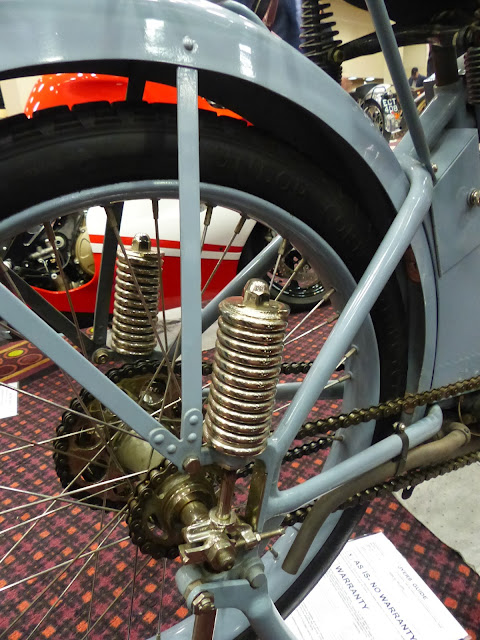Pope V-Twin
Pope’s big 999cc V-twin engine, with its overhead valvegear, was one of motorcycling’s most sophisticated and powerfid units when it was introduced in 1912.
As well as handsome looks, the Pope featured a high quality chassis with leaf-spring front suspension and an advanced plunger system at the rear.
Pope built its big lOOOcc V-twins for only seven years from 1912, but during that time they were among America’s most sophisticated bikes, and some of the fastest too.
The firm from Westfield in Massachusetts equipped its flagship with overhead valvegear. plus suspension at both front and rear. Few rival bikes could match that specification, and Pope riders had some notable racing successes.
Albert Pope was first a military man, serving as a lieutenant colonel in the Union Army during America’s Civil War, and was then a leading figure in the country’s transportation industry. In the 1870s he began by importing and then manufacturing bicycles, and progressed to automobile production before the turn of the century. His American Cycle Manufacturing Company then turned to making motorcycles, which initially followed the bicycles by being marketed using a variety of brand names including Columbia, American and Monarch.
Motorcycles were first built under the Pope name in 1911 (Pope himself had died in 1909), at which time they were fairly humble single-cylinder machines with conventional inlet-over-exhaust valvegear and leaf-spring front suspension. But the following year the firm uprated the single with pushrod-operated overhead valvegear, and also doubled up the cylinders to create a powerful lOOOcc V-twin.
Fast enough to race
This was an important development, because at the time the only other American firm with overhead- valve engines was Indian, and these were limited to the exotic four-valve singles and eight-valve V-twin racers. The production Pope was so fast that some hard-riding owners were competitive against professional riders in local race meetings. In 1913, Pope riders scored some notable successes against established marques such as Indian and Excelsior.
Pope’s management was encouraged by this, and created a factory team for the following year’s high-profile events. But their hopes were dashed, because the bikes’ supposed main asset, their overhead valvegear, turned out to be the weak link. Problems, including broken rocker arms, put out all of the Pope factory riders at the 1914 season’s big 300-mile (483km) events at Venice, California and Dodge City, after which the firm was not seen again in major competition.
The big Pope was an impressively fast and .apable roadster, even so. In standard form the V- r in was capable of well over 60mph (97km/h),
And its sophisticated features included two-speed transmission and a shaft-driven Bosch magneto. The chassis was also cleverly designed. The rames front section was a simple single downtube at bolted to the motor, and held leaf-spring front --.^pension. But the Pope was far ahead of its time having a version of the plunger-type rear --'tension that would be commonly adopted more man 20 years later.
This gave the Pope a comfortable ride, in . ^junction with the conventional sprung saddle, Mil was not enough to ensure the machine’s lasting success. The Pope Motorcycle Division remained a part of the Pope automotive group, which was one of the American industry’s largest. The parent company had been beneficial in providing cash for the bike firm’s short-lived racing campaign.
However, this also meant that the fortunes of Pope motorcycles were dependent on the fluctuating financial health of the automotive group. Some improvements were made to the V- twin in the years from 1913, but Pope lacked the investment to compete during a period of rapid advance by the ‘Big Three’ of Harley. Indian and Excelsior. By 1918, a new Schebler carburettor had helped increase the V-twin’s performance, but financial problems forced an end to Pope’s motorcycle production.
A sprung saddle was a typical feature of the day, and in the Pope's case gave a notably comfortable ride with the added assistance of the plunger rear suspension system.
The Pope was a fast and comfortable roadster with a top speed of about 70mph (ll3kmih), and also enjoyed a brief success on the racetrack before the advanced valve system gave problems.
Pope V-Twin Specification (1914)
- Engine Air-cooled ohv pushrod four-valve V-twin
- Capacity 999cc (84.5 x 89mm)
- Maximum power 12bhp
- Transmission Three-speed, chain final drive
- Frame Steel single downtube
- Suspension Leaf spring front; plunger rear
- Brakes None front; drum rear
- Weight 305lb (138kg)
- Top speed 70mph (113km/h)


















0 comments: